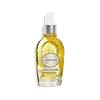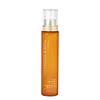What's inside
What's inside
 Key Ingredients
Key Ingredients

 Benefits
Benefits

 Concerns
Concerns

 Ingredients Side-by-side
Ingredients Side-by-side

Prunus Amygdalus Dulcis Oil
Skin ConditioningCaprylic/Capric Triglyceride
MaskingParfum
MaskingOleyl Alcohol
EmollientCamelina Sativa Seed Oil
Skin ConditioningRosa Canina Fruit Oil
EmollientHelianthus Annuus Seed Oil
EmollientCitrus Aurantium Bergamia Fruit Oil
MaskingDaucus Carota Sativa Root Extract
Skin ConditioningHippophae Rhamnoides Fruit Oil
Skin ProtectingDioleyl Tocopheryl Methylsilanol
AntioxidantTocopherol
AntioxidantLimonene
PerfumingCoumarin
PerfumingLinalool
PerfumingCitral
PerfumingPrunus Amygdalus Dulcis Oil, Caprylic/Capric Triglyceride, Parfum, Oleyl Alcohol, Camelina Sativa Seed Oil, Rosa Canina Fruit Oil, Helianthus Annuus Seed Oil, Citrus Aurantium Bergamia Fruit Oil, Daucus Carota Sativa Root Extract, Hippophae Rhamnoides Fruit Oil, Dioleyl Tocopheryl Methylsilanol, Tocopherol, Limonene, Coumarin, Linalool, Citral
Dimethicone
EmollientIsononyl Isononanoate
EmollientC12-15 Alkyl Benzoate
AntimicrobialDimethiconol
EmollientCaprylyl Methicone
Skin ConditioningIsopropyl Palmitate
EmollientDimethicone/Vinyl Dimethicone Crosspolymer
Skin ConditioningArgania Spinosa Kernel Oil
EmollientCamellia Japonica Seed Oil
EmollientTetrahexyldecyl Ascorbate
AntioxidantPropylene Glycol Caprylate
Skin ConditioningOcimum Sanctum Leaf Extract
Skin ConditioningParfum
MaskingPalmitic Acid
EmollientDimethylmethoxy Chromanol
AntioxidantBenzoic Acid
MaskingDimethicone, Isononyl Isononanoate, C12-15 Alkyl Benzoate, Dimethiconol, Caprylyl Methicone, Isopropyl Palmitate, Dimethicone/Vinyl Dimethicone Crosspolymer, Argania Spinosa Kernel Oil, Camellia Japonica Seed Oil, Tetrahexyldecyl Ascorbate, Propylene Glycol Caprylate, Ocimum Sanctum Leaf Extract, Parfum, Palmitic Acid, Dimethylmethoxy Chromanol, Benzoic Acid
 Reviews
Reviews

Alternatives
Ingredients Explained
These ingredients are found in both products.
Ingredients higher up in an ingredient list are typically present in a larger amount.
Parfum is a catch-all term for an ingredient or more that is used to give a scent to products.
Also called "fragrance", this ingredient can be a blend of hundreds of chemicals or plant oils. This means every product with "fragrance" or "parfum" in the ingredients list is a different mixture.
For instance, Habanolide is a proprietary trade name for a specific aroma chemical. When used as a fragrance ingredient in cosmetics, most aroma chemicals fall under the broad labeling category of “FRAGRANCE” or “PARFUM” according to EU and US regulations.
The term 'parfum' or 'fragrance' is not regulated in many countries. In many cases, it is up to the brand to define this term.
For instance, many brands choose to label themselves as "fragrance-free" because they are not using synthetic fragrances. However, their products may still contain ingredients such as essential oils that are considered a fragrance by INCI standards.
One example is Calendula flower extract. Calendula is an essential oil that still imparts a scent or 'fragrance'.
Depending on the blend, the ingredients in the mixture can cause allergies and sensitivities on the skin. Some ingredients that are known EU allergens include linalool and citronellol.
Parfum can also be used to mask or cover an unpleasant scent.
The bottom line is: not all fragrances/parfum/ingredients are created equally. If you are worried about fragrances, we recommend taking a closer look at an ingredient. And of course, we always recommend speaking with a professional.
Learn more about Parfum